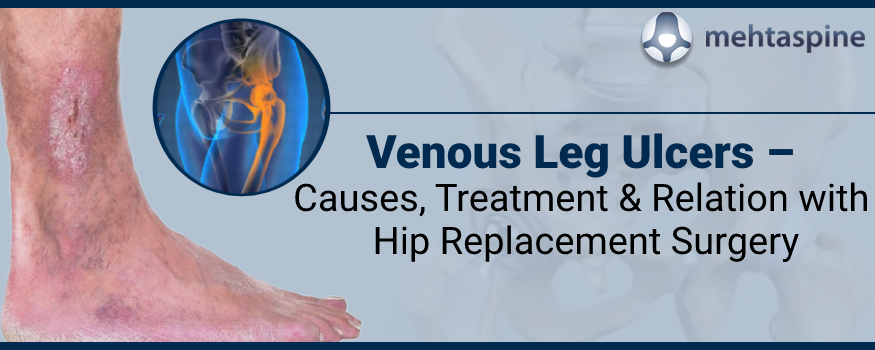Leg Vein Ulcers – Causes, Treatment and Association with Hip Replacement Surgery
Venous leg ulcers are painful sores on the inside of the leg that usually taking more than 2 weeks to heal. They are open sores that commonly develop above the ankles causing pain, itching, and swelling in the area affected.
These venous leg ulcers may result in swollen ankles, local discolouration, itchy flaky skin and foul discharge. While risk factors of venous leg ulcers may include health conditions like obesity and medical conditions like varicose veins it was also observed that the incidence of venous leg ulcers tends to be more after hip replacement surgery.
So in this blog, we discuss causes, treatment options for venous leg ulcers. And then discuss the relation between hip replacement surgery and venous leg ulcers based on research study conducted by Children and Adult Spinal Surgeon Mr Jwalant S Mehta and his team of medical researchers. Read on:
What causes venous leg ulcers?
Damage to the valves inside the legs is the root cause of venous ulcers. These valves regulate the blood pressure in the veins every time we walk. When these valves do not work properly the blood pressure in the legs may consistently surge. This sustained pressure on the veins may damage them internally and this increases the skin breaking out in the form of an open sore even for a minor injury, causing an ulcer. These Ulcers are open sores that may occur in any area of skin but commonly happen on the legs.
In addition to the malfunctioning of valves, varicose veins or chronic venous insufficiency where the blood pools in the leg may also cause venous leg ulcers.
Who is at more risk of developing venous leg ulcers?
Having a specific condition that creates blood flow problems in the legs may increase the risk of venous leg ulcers. Obesity, previous history of Deep Vein Thrombosis, varicose veins, previous history of hip or knee replacement surgeries or even ageing may increase the risk of venous leg ulcers.
Treatment and Prevention of Venous Ulcers:
Cleaning, dressing, avoiding skin sensitive products, antibacterial ointments and oral antibiotic medicines are involved in treating venous ulcers.
However, it is better to take preventive measures especially if the patient is at high risk of venous leg ulcers. Avoiding smoking, losing weight, consistent activity to improve blood flow, exercise, and avoiding compression clothing are some of the preventive measures suggested.
Relation between Venous Leg Ulcers & Hip Replacement Surgery:
As mentioned in the risk factors above – knee and hip replacement surgeries happen to increase the risk of suffering venous leg ulcers. The risk is closely related to Deep Vein Thrombosis which is commonly found in patients after hip replacement surgery. Research studies were performed to estimate the incidence of venous leg ulcers in patients post hip replacement surgery.
Children and Adult Spinal Surgeon Mr Jwalant S Mehta along with N. Nicolaou, S. Kiryluk, M. J. F. Fordyce from The Horder Centre for Arthritis, Crowborough, England performed an extensive research study to evaluate the incidence of venous leg ulcers after hip replacement surgery.
The extensive study that was performed with 816 patients concluded that leg ulcers tend to develop more commonly on the operated side after a mean period of 5.8 years posts the first arthroplasty.
You can find details about this research study performed by Children and Adult Spinal Surgeon Mr Jwalant S Mehta, here: https://www.mehtaspine.co.uk/presentations/venous-ulcers-jbjs.pdf


